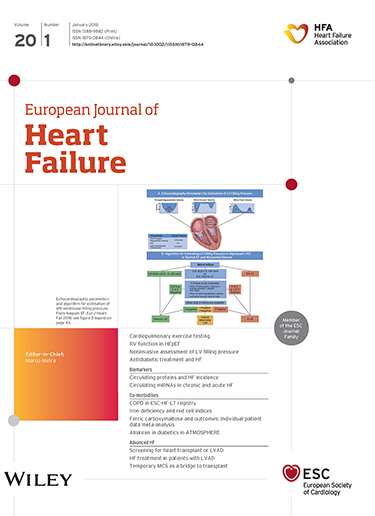Integrated role of cardiac magnetic resonance and genetics in predicting left ventricular reverse remodelling in dilated and non-dilated cardiomyopathy.
IF 16.9
1区 医学
Q1 CARDIAC & CARDIOVASCULAR SYSTEMS
引用次数: 0
Abstract
AIMS Left ventricular reverse remodelling (LVRR) is a prognostic marker in patients with dilated (DCM) and non-dilated left ventricular cardiomyopathy (NDLVC). The utility of combining late gadolinium enhancement (LGE) and genetic testing in predicting LVRR in DCM/NDLVC remains a knowledge gap. This study aimed to assess an integrated approach including LGE data and genetics to predict LVRR in DCM/NDLVC patients. METHODS AND RESULTS This multicentre observational study included DCM/NDLVC patients with: (i) baseline echocardiographic left ventricular ejection fraction (LVEF) <50%; (ii) genetic testing; (iii) baseline cardiac magnetic resonance (CMR); (iv) 12-month follow-up echocardiographic data. LVRR was defined as LVEF increase ≥10% or LVEF ≥50% (if baseline LVEF <45%) at 12 months. Outcome measures were: (i) all-cause mortality, heart transplant, or left ventricular assist device implantation (D/HT/LVAD); (ii) sudden cardiac death or major ventricular arrhythmias (SCD/MVA). Arrhythmogenic genes studied were LMNA, DSP, FLNC, and RBM20. Among 1757 DCM/NDLVC with genetic data, 616 met eligibility (462 DCM, 154 NDLVC; age 51 ± 14 years, 34% female). LVRR occurred in 314 patients (51%): 251 (54%) in DCM and 63 (41%) in NDLVC (p = 0.004). Independent predictors of LVRR within 1 year included titin truncating variants, absence of arrhythmogenic genes, and absence of LGE ring-like pattern. In patients with LVEF <35%, only the presence of LGE ring-like pattern and arrhythmogenic genes remained independently related to a lower rate of LVRR and increased SCD/MVA risk. CONCLUSION In a large genetically and CMR characterized DCM/NDLVC cohort, arrhythmogenic genotypes and LGE ring-like pattern were inversely related to LVRR, particularly in patients with LVEF <35%.心脏磁共振和遗传学在预测扩张型和非扩张型心肌病左心室反向重构中的综合作用。
目的:左心室反向重构(LVRR)是扩张型(DCM)和非扩张型左室心肌病(NDLVC)患者的预后指标。晚期钆增强(LGE)和基因检测在预测DCM/NDLVC患者LVRR中的应用仍然是一个知识空白。本研究旨在评估包括LGE数据和遗传学在内的综合方法来预测DCM/NDLVC患者的LVRR。方法和结果这项多中心观察性研究纳入了DCM/NDLVC患者:(i)基线超声心动图左心室射血分数(LVEF) <50%;(ii)基因测试;(iii)基线心脏磁共振(CMR);(iv) 12个月随访超声心动图数据。LVRR定义为12个月时LVEF增加≥10%或LVEF≥50%(如果基线LVEF <45%)。结局指标为:(i)全因死亡率、心脏移植或左心室辅助装置植入(D/HT/LVAD);㈡心源性猝死或严重室性心律失常(SCD/MVA)。研究的致心律失常基因有LMNA、DSP、FLNC和RBM20。在1757例有遗传数据的DCM/NDLVC中,616例符合条件(DCM 462例,NDLVC 154例;年龄(51±14岁),女性占34%。LVRR发生314例(51%),DCM 251例(54%),NDLVC 63例(41%)(p = 0.004)。1年内LVRR的独立预测因子包括titin截断变异、不存在致心律失常基因和不存在LGE环样模式。在LVEF <35%的患者中,只有LGE环状模式和心律失常基因的存在与LVRR发生率较低和SCD/MVA风险增加独立相关。结论在一个具有遗传和CMR特征的大型DCM/NDLVC队列中,心律失常基因型和LGE环状模式与LVRR呈负相关,特别是在LVEF <35%的患者中。
本文章由计算机程序翻译,如有差异,请以英文原文为准。
求助全文
约1分钟内获得全文
求助全文
来源期刊

European Journal of Heart Failure
医学-心血管系统
CiteScore
27.30
自引率
11.50%
发文量
365
审稿时长
1 months
期刊介绍:
European Journal of Heart Failure is an international journal dedicated to advancing knowledge in the field of heart failure management. The journal publishes reviews and editorials aimed at improving understanding, prevention, investigation, and treatment of heart failure. It covers various disciplines such as molecular and cellular biology, pathology, physiology, electrophysiology, pharmacology, clinical sciences, social sciences, and population sciences. The journal welcomes submissions of manuscripts on basic, clinical, and population sciences, as well as original contributions on nursing, care of the elderly, primary care, health economics, and other related specialist fields. It is published monthly and has a readership that includes cardiologists, emergency room physicians, intensivists, internists, general physicians, cardiac nurses, diabetologists, epidemiologists, basic scientists focusing on cardiovascular research, and those working in rehabilitation. The journal is abstracted and indexed in various databases such as Academic Search, Embase, MEDLINE/PubMed, and Science Citation Index.
 求助内容:
求助内容: 应助结果提醒方式:
应助结果提醒方式:


